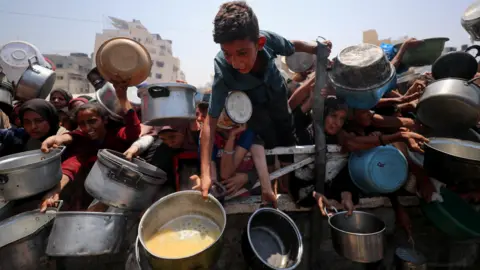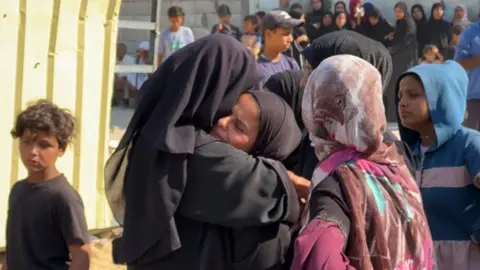Gaza Aid Crisis: Bowen Condemns Desperate Airdrops
Starvation in Gaza: Is Air-Dropping Aid a Solution or a PR Stunt?
 **Imagine this:** Thousands of desperate families huddled in overcrowded Gaza, facing starvation. Now imagine pallets of aid, parachuting from the sky – a lifeline? Or a dangerous gamble? The recent offer by Israel to airdrop aid into Gaza sparks a crucial question: is this a genuine humanitarian effort, or a carefully crafted image fix?
**Imagine this:** Thousands of desperate families huddled in overcrowded Gaza, facing starvation. Now imagine pallets of aid, parachuting from the sky – a lifeline? Or a dangerous gamble? The recent offer by Israel to airdrop aid into Gaza sparks a crucial question: is this a genuine humanitarian effort, or a carefully crafted image fix?
 A Desperate Measure: Airdropping Aid to Gaza
A Desperate Measure: Airdropping Aid to Gaza
 Britain, France, and Germany issued a stark warning on July 25th: "Israel must uphold its obligations under international humanitarian law" and allow unrestricted aid access to Gaza. Their concerns echo the UN and numerous humanitarian NGOs witnessing a catastrophic humanitarian crisis. Yet, Israel maintains it has placed *no* restrictions on aid trucks entering Gaza. This claim is vehemently disputed by its allies and international organizations on the ground. But why the disagreement? Discover the truth behind this escalating crisis.
Britain, France, and Germany issued a stark warning on July 25th: "Israel must uphold its obligations under international humanitarian law" and allow unrestricted aid access to Gaza. Their concerns echo the UN and numerous humanitarian NGOs witnessing a catastrophic humanitarian crisis. Yet, Israel maintains it has placed *no* restrictions on aid trucks entering Gaza. This claim is vehemently disputed by its allies and international organizations on the ground. But why the disagreement? Discover the truth behind this escalating crisis.
 Lessons from Past Conflicts: A Risky Undertaking
Lessons from Past Conflicts: A Risky Undertaking
 We've seen airdrops before – in Iraqi Kurdistan after the 1991 Gulf War, and during the siege of Mostar in 1993. I witnessed firsthand the chaos and dangers. Imagine the scene: C-130 transport planes, thousands of feet above desperate refugees, releasing pallets of supplies. Sounds heroic, right? But the reality was far more brutal. In Kurdistan, young men risked their lives running into minefields for aid; families were crushed by falling pallets. In Mostar, aid landed amidst shelling, crashing through already fragile homes. Air-dropping aid is a chaotic, often deadly, last resort.
We've seen airdrops before – in Iraqi Kurdistan after the 1991 Gulf War, and during the siege of Mostar in 1993. I witnessed firsthand the chaos and dangers. Imagine the scene: C-130 transport planes, thousands of feet above desperate refugees, releasing pallets of supplies. Sounds heroic, right? But the reality was far more brutal. In Kurdistan, young men risked their lives running into minefields for aid; families were crushed by falling pallets. In Mostar, aid landed amidst shelling, crashing through already fragile homes. Air-dropping aid is a chaotic, often deadly, last resort.
 Gaza's Unique Challenges: Why Airdrops Are Likely to Fail
Gaza's Unique Challenges: Why Airdrops Are Likely to Fail
 This isn't Kurdistan or Bosnia. Gaza is densely populated, with limited open spaces. Imagine the scene: desperate men fighting over scarce supplies, criminal elements seizing the opportunity for profit. Will this chaotic scramble for survival actually feed the starving? The answer is likely to be no. Why? Even massive transport planes carry far less than a convoy of trucks, and parachuted pallets often land miles from their intended recipients. The logistical nightmare is compounded by Israel’s actions, which have forced hundreds of thousands into a tiny coastal area. Effective aid delivery demands an open, organized route – something currently lacking in Gaza. Ashdod, Israel's modern container port, is a short drive north. The Jordanian border offers another viable supply route.
The Real Solution: A Ceasefire and Unrestricted Access
Air-dropping aid is a PR Band-Aid on a gaping wound. Only a ceasefire and the establishment of long-term, unrestricted aid operations can truly address the humanitarian crisis in Gaza. The question remains: Will the world allow political maneuvering to overshadow the urgent need for a real solution? This conflict needs more than a televised spectacle – it needs lasting peace and effective aid delivery. The choice is clear: continue down the path of potentially deadly desperation, or pave the way for a true solution. What will it be?
This isn't Kurdistan or Bosnia. Gaza is densely populated, with limited open spaces. Imagine the scene: desperate men fighting over scarce supplies, criminal elements seizing the opportunity for profit. Will this chaotic scramble for survival actually feed the starving? The answer is likely to be no. Why? Even massive transport planes carry far less than a convoy of trucks, and parachuted pallets often land miles from their intended recipients. The logistical nightmare is compounded by Israel’s actions, which have forced hundreds of thousands into a tiny coastal area. Effective aid delivery demands an open, organized route – something currently lacking in Gaza. Ashdod, Israel's modern container port, is a short drive north. The Jordanian border offers another viable supply route.
The Real Solution: A Ceasefire and Unrestricted Access
Air-dropping aid is a PR Band-Aid on a gaping wound. Only a ceasefire and the establishment of long-term, unrestricted aid operations can truly address the humanitarian crisis in Gaza. The question remains: Will the world allow political maneuvering to overshadow the urgent need for a real solution? This conflict needs more than a televised spectacle – it needs lasting peace and effective aid delivery. The choice is clear: continue down the path of potentially deadly desperation, or pave the way for a true solution. What will it be?

Image 1

Image 2

Image 3

Image 4

Image 5

Image 6

Image 7
Comments
Post a Comment